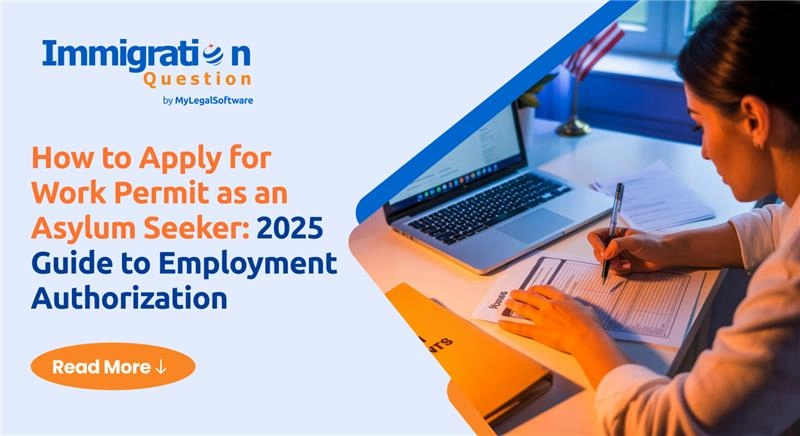Seeking asylum in the United States is already a complex and emotional journey. Trying to figure out how to legally work while your case is pending adds another layer. Many asylum seekers need a way to support themselves and their families. And for this to work, getting an asylum work permit (Employment Authorization Document (EAD)) is the key.
In this guide, we’ll walk you through everything you need to know about applying for a work permit as an asylum seeker, from eligibility rules and timelines to the actual application process and what happens if your case is denied. Let’s break it down.
What is an Asylum Work Permit and Who Qualifies?
An asylum work permit, or asylum employment authorization, allows individuals who are waiting for a decision on their asylum application to legally work in the United States. You apply for this document using Form I-765: Application for Employment Authorization.
There’s an important distinction here: asylum seekers have applied for protection but haven’t yet been approved, while asylees have already received asylum status. Asylum seekers fall under the (c)(8) category when applying for work authorization.
To qualify for asylum work authorization, you must:
- Have filed a complete, non-frivolous asylum application with either USCIS or the Immigration Court
- Be physically present in the United States
- Not be in lawful permanent resident status
- Not have your asylum application denied by an Immigration Judge (unless you’ve filed an appeal)
Can an Asylum Seeker Work in the United States?
Yes, but not right away. The United States does not allow asylum seekers to work immediately after filing for asylum. And that’s why they need the work permit. You can apply for work authorization once your asylum case has been pending for at least 150 days. This is known as the “Asylum Clock.”
Until you receive your EAD, you are not legally allowed to work. Asylees, on the other hand, are authorized to work without needing a separate permit.
The 150-Day Rule: When Can You Apply for Work Permit?
The rule is pretty straightforward: after your asylum application has been pending for 150 days, you can submit your application for a work permit. But you’ll need to wait another 30 days (180 days total) before USCIS approves and issues your work authorization.
This 150-day period only includes the time when your case is actively being processed. If you cause any delays—like missing an interview or asking for an extension, the clock automatically pauses. So, it’s important to avoid unnecessary delays that could push back your eligibility.
How Can You Apply for Work Permit as an Asylum Seeker?
Here’s a breakdown of the application process:
- Complete Form I-765. Apply under category (c)(8).
- Gather supporting documents – a copy of your asylum receipt notice, any government-issued IDs, and passport-style photos.
- Submit the application to USCIS. Follow all instructions carefully.
Double-check everything before you send it off. Common mistakes like missing signatures or incorrect categories can delay the process.
Are Asylum Seekers Allowed to Work While Application is Pending?
No, asylum seekers cannot legally work while their application is pending unless they’ve received an approved EAD. Once you get your asylum work permit, you’re allowed to work for any employer in the U.S.
If your asylum application is denied, your work authorization will typically expire at the end of its validity period. However, if you appeal your denial, you may still qualify to renew your work permit while your appeal is pending.
How Long Does It Take to Get an Asylum Work Permit?
Processing times can vary, but most applicants receive their asylum work permit within 3-6 months or more after applying. It depends on USCIS’s backlog and the peculiarity of your case.
You can check your asylum work permit processing time on the USCIS website using your receipt number. In urgent situations – like medical needs or risk of job loss – you may request expedited processing, though it’s not guaranteed.
Can an Asylee Work Without EAD?
Yes. If you’ve been granted asylum status, you don’t need a separate work permit to work in the U.S. Your asylum approval alone gives you the legal right to work with any employer.
However, some asylees still apply for an EAD because it serves as a convenient form of ID and employment authorization. Transitioning from asylum seeker to asylee means you no longer have to worry about the asylum clock or renewal deadlines for work permits.
What If My Work Permit Expires While My Asylum Case Is Pending?
If your asylum case is still pending and your current work permit is about to expire, you can apply to renew it. File a new Form I-765 with updated supporting documents.
Renewal applications should be submitted around 180 days before your current EAD expires. That way, you can continue working without interruption. Always plan ahead to avoid any gaps in employment authorization.
Final Thoughts
If you’re seeking asylum in the United States, getting your asylum work permit is an important step toward building stability. You can’t work immediately, but once you’ve reached 150 days and filed the right paperwork, you’re on your way to legal employment.
Apply early, avoid delays, and keep track of your timeline. If you ever feel unsure, it’s wise to consult with a qualified immigration attorney.
At Immigration Question, you can ask your questions on the open forum and get answers within hours. You can also choose an attorney from our network of experienced attorneys who can guide you through every step of the work permit application process and help ensure your asylum case is handled properly.
Frequently Asked Questions
1. How long does it take to get a work permit after applying for asylum?
Once you apply, it typically takes 3–6 months or more to receive your asylum work permit, depending on USCIS processing times.
2. Can I apply for work permit immediately after filing asylum application?
No. You must wait until your asylum application has been pending for at least 150 days before applying.
3. What happens to my work permit if my asylum case is denied?
Your work permit remains valid until its expiration date. If you appeal, you may still qualify for renewal.
4. Can my family members get work permits based on my asylum case?
Yes, if they are listed as derivatives on your asylum application, they may also qualify for work authorization in the U. S.





![Top 5 Immigration Questions People Asked Online This Week [June 13, 2025]](https://blog.immigrationquestion.com/wp-content/uploads/2025/06/top-5-immigration-questions-people-asked-online-this-week-june-13-2025-768x419.webp)



